With its crime-free environment, well-maintained campsites, and simple main road, Iceland is an excellent place to visit by campervan.
I was initially hesitant, but it became one of my favorite travel adventures, and here, I share firsthand tips and lessons learned. This post covers:
- 🚐 How to rent a campervan
- 🏕️ What to expect at campsites
- 🎒 What to pack for a campervan
- 🌭 Tips for preparing meals
- 🚙 Iceland driving rules and norms
🇮🇸 Planning a Trip to Iceland: 11 Practical Things To Know
- Why a Campervan?
- About My Trip
- Renting a Campervan
- Iceland Campsites
- Planning Meals
- Road Rules & Driving
- What To Pack
- Iceland Campervan Trip Planner
Lists By Lukiih is readers-supported. When you buy with my affiliate link, I may earn a small commission. Thanks!
Why Travel Around Iceland in a Campervan?
If it’s your first time traveling anywhere in a campervan and you’re hesitant about it like I was, here are the reasons to consider doing it in Iceland:
🏕️ 1. Iceland campsites are well-maintained and accessible.
Traveling in a campervan in Iceland is not “roughing it” like camping can be.
In Iceland, you can stay in clean campsites with kitchen facilities and hot showers. You can cook outdoors, but you can also make meals at a campsite facility or drive to a restaurant.
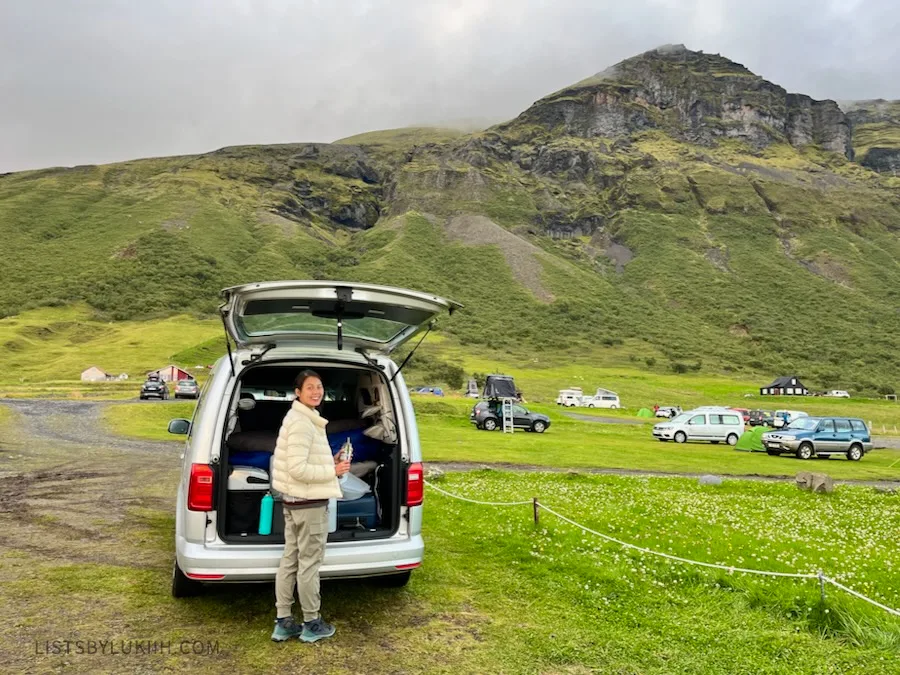
💰 2. Traveling around Iceland in a campervan is cheaper.
Iceland is one of the most expensive destinations in the world. My camper rental was high because I booked it at the last minute (about three weeks ahead), but traveling in one is much more economical if you book early.
I share all my travel expenses in this Iceland trip budget breakdown.
🚙 3. The Ring Road is straightforward.
The main road that wraps around Iceland is the Ring Road. It’s straightforward, well-paved, and two-lane.
Everyone visiting Iceland has to travel by vehicle (e.g., by bus, car, or van) on the Ring Road, and it’s common to see campervans. Having done it, I think campervanning is the best way to enjoy the country’s raw natural beauty.
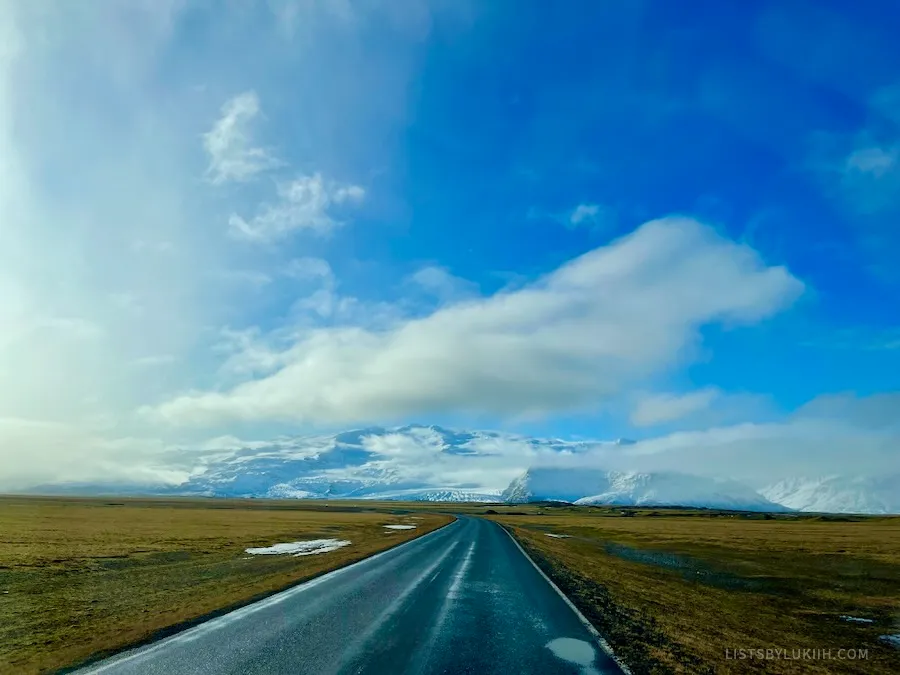
🦺 4. Iceland is one of the safest countries in the world.
According to the Global Peace Index, Iceland is the safest country in the world. Crime is uncommon and very low due to the high standard of living.
Campervanning in Iceland doesn’t pose any significant risks. Many tourists visit by campervan, so you won’t be alone.
⛰️ 5. Driving around Iceland is breathtaking.
Driving in Iceland is unlike driving in many other places. You’re surrounded by beautiful mountains and landscapes you can enjoy at your own pace.
It’s incredible to wake up in your camper and immediately see the stunning nature surrounding you. If you travel in the winter, you can see the northern lights right outside.
Traveling in a campervan is especially beautiful during the warm months. See what it’s like to visit Iceland in the summer.
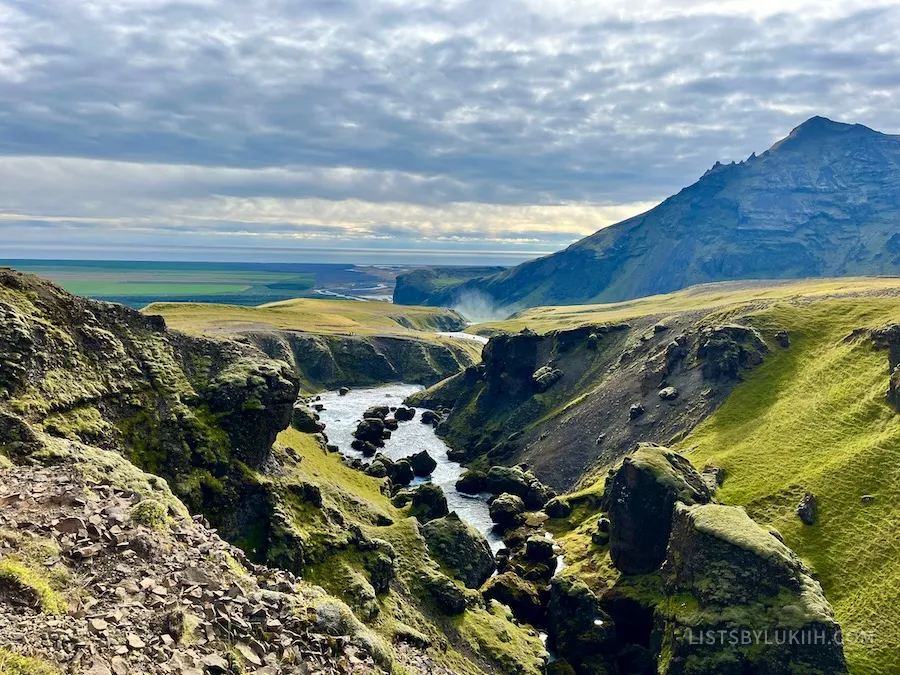
About My Iceland Trip
To give context to this campervan guide, here’s what you need to know about my trip to Iceland:
- 🗓️ One week – I spent a week campervanning in Iceland, thoroughly exploring the South Coast from the Golden Circle to Jökulsárlón. With only a week at my disposal, I decided not to do the entire Ring Road because I would have felt rushed.
See the highlights of my trip in this epic Iceland itinerary.
- ☀️ Summer season – I visited Iceland in August, the end of the high season. Although weather conditions are volatile year-round, the summer months are much warmer (45 °F to 55 °F) and more crowded.
During the summer months in Iceland, the sun rises early (between 3 am and 6 am) and sets late (between 9 pm and 12 am), a phenomenon known as the midnight sun. The long days give you more time to explore.
That said, a friend used my Iceland campervan guide to plan her winter trip, so it works for either season:
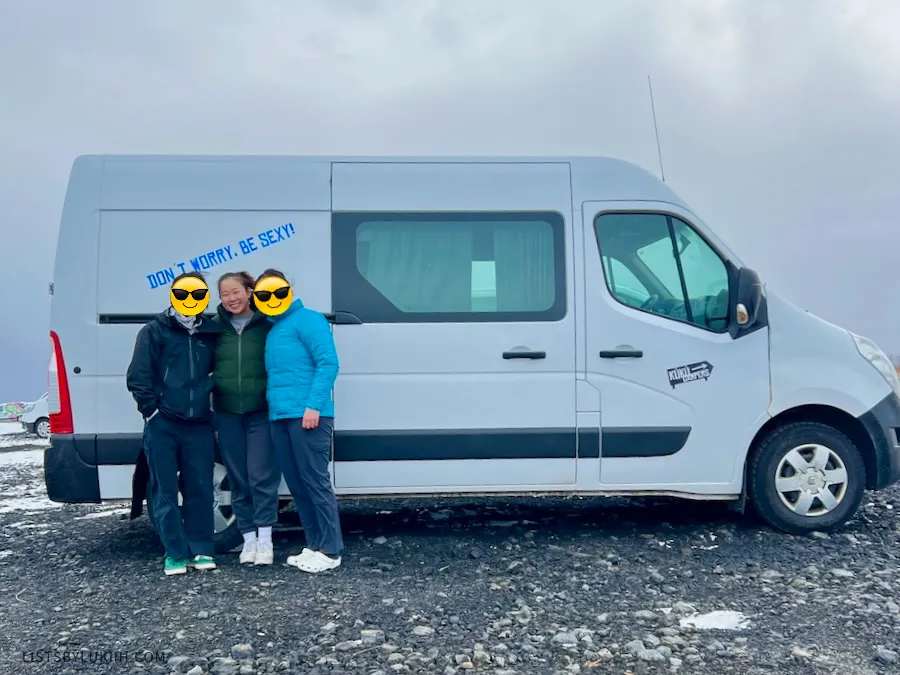
- ✌️ Two travelers – I traveled with one other person, so I was able to split accommodation, food, and transportation costs. I was in a standard two-person camper that seats four and sleeps two people.
- ⛺ Campsites – I list and comment on the campsites I stayed at in this one-week Iceland itinerary. Although I don’t have much camping experience, this is not my first time doing it.
All prices mentioned here are in USD 💵 .
5 Tips on Renting a Campervan in Iceland
Once you’ve decided to visit Iceland by camper, the first step is to pick and rent a campervan. Here are five things to know about renting a van there.
🗓️ 1. Book your campervan four months ahead.
If you can only drive an automatic and are traveling in the summer, you should book your Iceland campervan four or more months in advance. Otherwise, your options will quickly become limited and expensive.
In Iceland, there is a higher demand for automatic and smaller campers; booking in advance is even more important.
🍀 My Experience Booking a Campervan at the Last Minute
I searched for a campervan a month ahead during peak season, and almost all 20+ camper rental sites I checked were completely booked.
After anxiously searching for campers, I changed my travel dates to match camper availability since my options were too limited.
💰 Iceland Campervan Costs: Booking Early vs. Last Minute
A friend also went to Iceland during peak season and rented a similar two-person campervan five months ahead, unlike me. Here’s a comparison of our experience:
| Friend’s Experience | My Experience | |
|---|---|---|
| Booking Time | 6 months ahead | 1 month ahead |
| Cost For 1 Week | $1,100 | $2,400 |
| Cost Per Day | $220 | $300 |
| Rental Company | Top Company | Company with Inconsistent Reviews |

🔍 2. Start your campervan search with reputable rental companies.
Iceland has several popular and highly-rated companies, including Happy Campers, KuKu Campers, Camp Easy, Go Campers, and Cozy Campers. Start your campervan search with one of those companies to minimize stress and risks.
Many campers will provide the same equipment (e.g., a sleeping bag, window covers, cooking equipment, cooler), but the quality of the equipment will vary depending on the rental company.
🍀 My Campervan Experience: Since I searched at the last minute, I booked my rental with a company with inconsistent reviews. My campervan wasn’t in the best shape (e.g., the window covers were not entirely intact, so I had less privacy at night), but the customer service was good, and I had no issues.
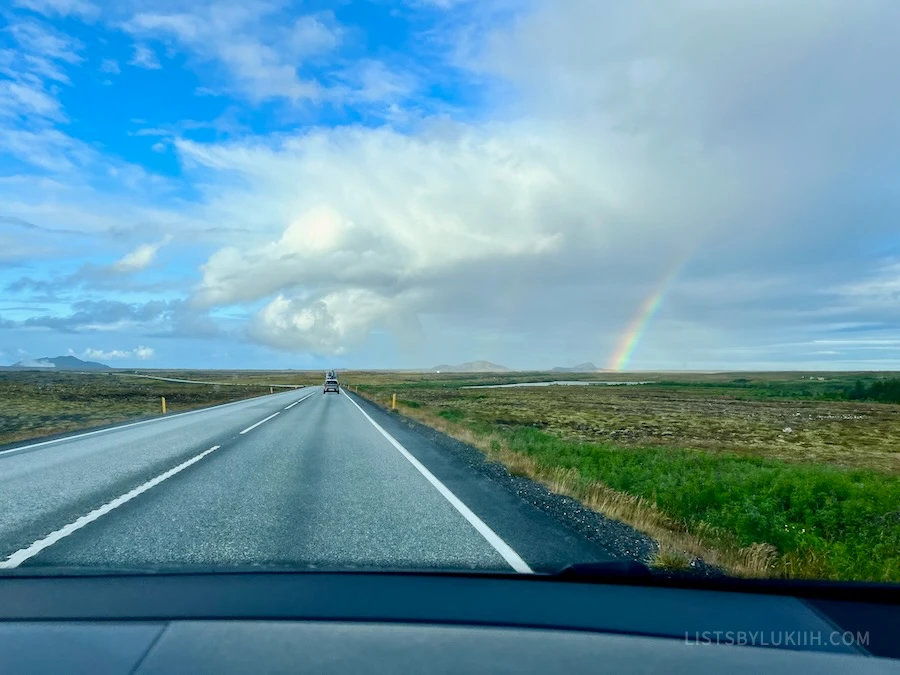
🚐 3. Choose a campervan that fits your needs.
Just like renting a car, you can rent different types of campervans. When choosing which one to rent, consider these three important criteria:
Criteria #1: Automatic vs. Manual Transmission
Manual transmissions are cheaper, more fuel-efficient, and lighter, but many visitors like me only know how to drive automatics.
If you can only drive an automatic transmission, you will have slightly fewer options when renting a campervan in Iceland, as most vehicles are manual.
Criteria #2: Campervan Size
Most standard campervans accommodate two to four people. Some can fit up to five people, but anything bigger is considered a motorhome.
When choosing a van size, consider the number of people in your group and the size you are comfortable driving.
You can also rent a smaller campervan if some people in your group are okay with sleeping in a tent instead of inside the camper where there’s likely a heater.
🍀 My Campervan Experience: I was traveling with just my partner, so we only needed a campervan that sleeps two and seats two. Since we booked at the last minute, we got a van that sat four and slept two, as our options were limited.
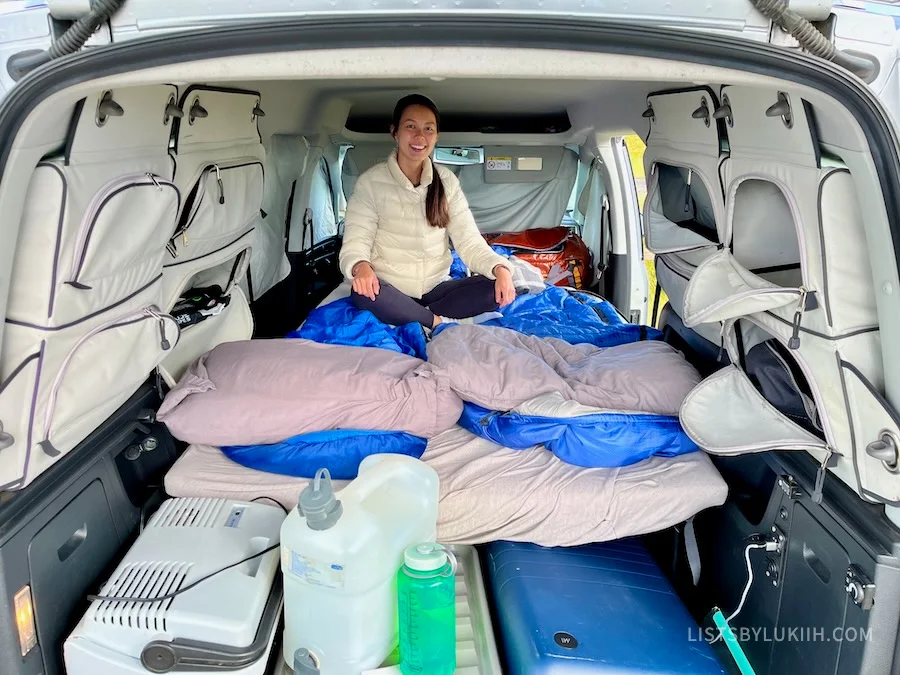
Criteria #3: Four-Wheel Drive (4WD) vs. Not
If you want to explore Iceland’s Highlands, the sparsely populated middle area of the country, you’ll drive on F-roads.
F-roads are Iceland’s mountain roads, and a 4WD vehicle is legally required to drive on them.
If you plan to stick to the Ring Road, you won’t need a 4WD campervan.
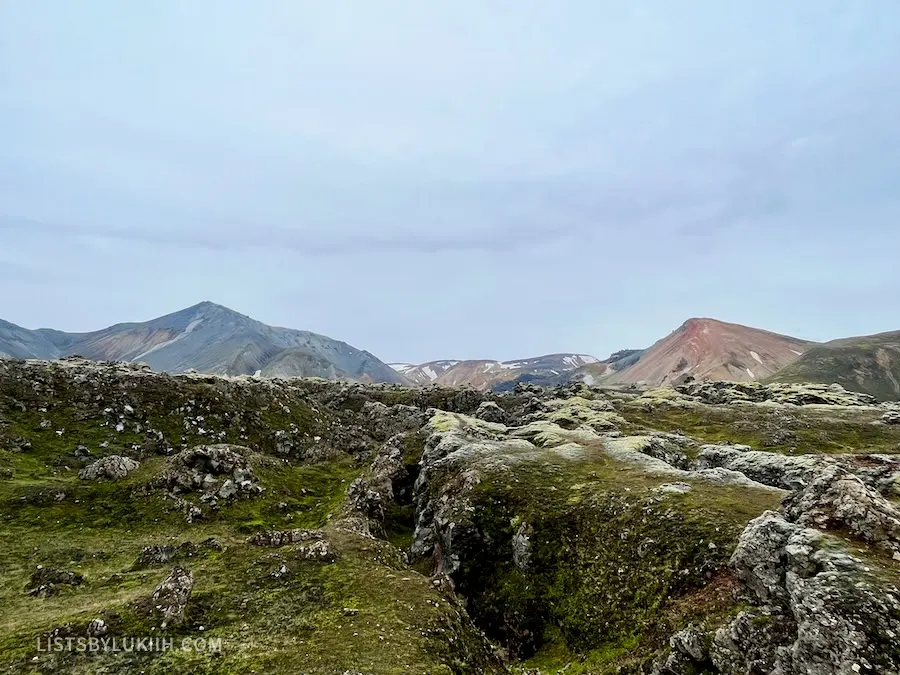
💨 4. Get only the necessary campervan insurance.
Campervan rental companies in Iceland offer various types of insurance. Familiarize yourself with Iceland’s insurance types so you only pay for what you need.
Many travel credit cards provide some coverage (e.g., Chase Sapphire Reserve, Venture X, American Express Platinum). Call your credit card company to see if campers are covered and under what requirements (e.g., do you need to deny insurance?). You may not need to purchase additional insurance.
Types of Campervan Insurance in Iceland
What campervan insurance you need and should get depends on your risk tolerance and the weather during your trip.
- Collision Damage Waiver – CDW is mandatory in Iceland and should be automatically included by your rental company. CDW means that there’s a limit to your liability.
- Sand and Ash Protection – SAAP is recommended for Iceland because it is windy, and volcanic ash and rocks can damage the campervan.
- Gravel Protection – GP is recommended if you drive on F-roads or deviate outside of the Ring Road.
- Theft Protection – TP is silly to get, and most people do not recommend it since theft rarely happens in this low-crime country.
Some Iceland rental companies offer an all-or-nothing insurance package (i.e., CDW-only or everything together).
🍀 My Campervan Experience: I paid $277 for my all-inclusive insurance package. I would have preferred a la carte insurance, but the upside of paying for the “premium” package is that they barely inspected the camper when I returned it. I didn’t have to worry about post-return charges that others have complained about.
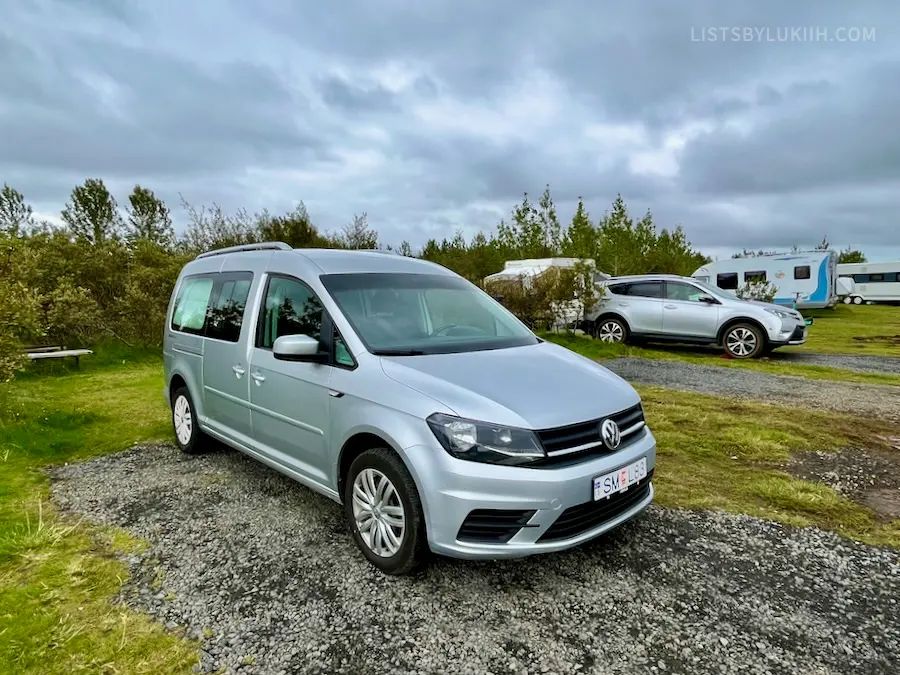
✅ 5. Double-check everything during the campervan walkthrough.
When you pick up your campervan in Iceland, the rental company will do a quick walkthrough with you. I’ve been advised to take the extra time to double-check everything; I now fully agree with this advice.
To ensure you don’t pay for damages or mistakes that are not your fault, consider doing the following during your campervan walkthrough:
- Take a video or photos of the camper – Some customers have complained about being charged for existing damages.
- Open and check equipment – My walkthrough guide said, “The van’s curtains are in those bags.” Since I didn’t open the bag, I only realized until later that the curtains were missing magnets. I didn’t have total privacy for my entire Iceland trip.
- Double-check how unfamiliar equipment works – During the walkthrough, I was shown that the cooler needed to be plugged in. I later couldn’t get the cooler to work and didn’t realize I was using the wrong plug (the one for the car battery instead of the external battery).
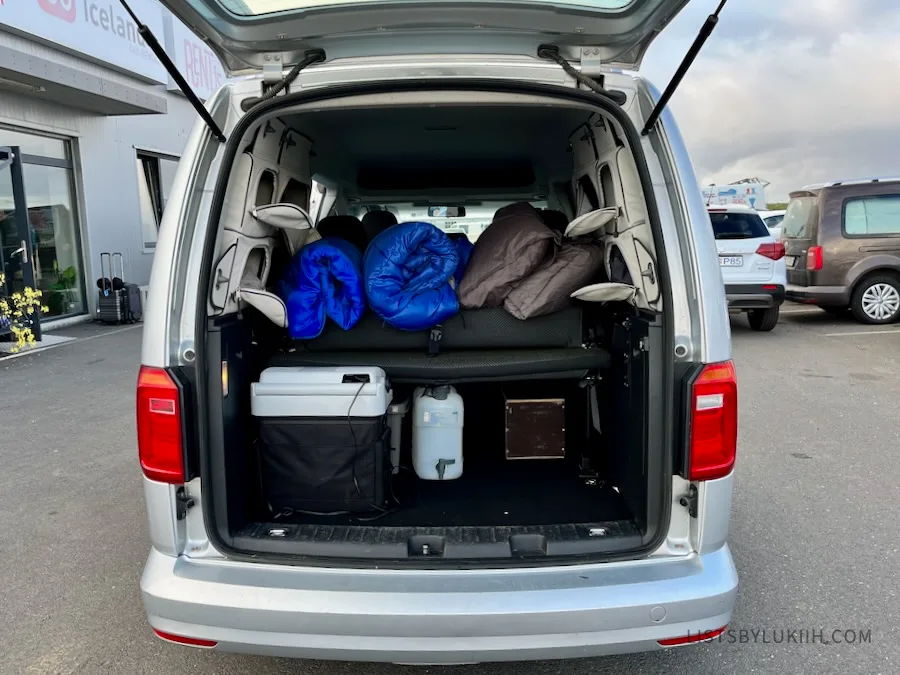
6 Things To Know About Campsites in Iceland
After booking a campervan rental, the next thing to consider is the campsites you’ll be staying at in Iceland. Here are five things to remember about their campsites.
😴 1. You cannot park your campervan anywhere in Iceland.
Despite the wide open spaces, you can’t park and sleep anywhere you want in Iceland. It’s illegal, and you will be heavily fined if caught.
You’re legally required to park your campervan on a campsite or private property with the landowner’s permission.
Be aware that Iceland campsites are just large patches of grass and not a parking lot. Most don’t have parking lines or marked separations, so park wherever there is space and try to leave room for others.
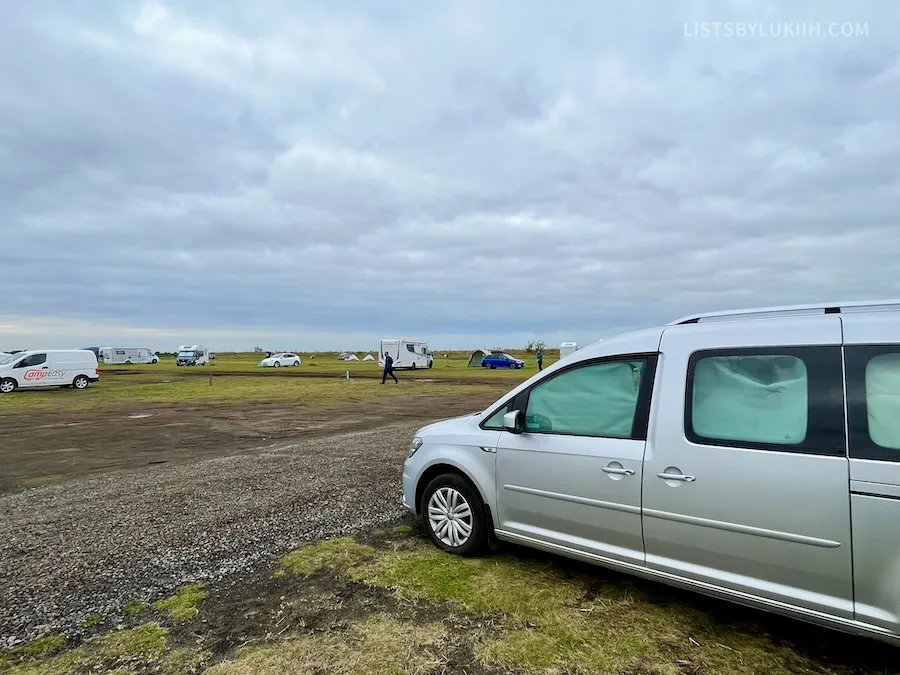
🏕️ 2. Most Iceland campsites don’t require reservations.
Since most campsites don’t require reservations, you can just show up. Visiting Iceland in a campervan allows you the flexibility to decide where to stay at the last minute.
However, it’s a good idea to know which campsites you want to stay at while building your driving itinerary. A handful of popular ones also have a reservation system (e.g., Reyjkavík Campsite, Lava Hostel, Grindavík Campsite).
Happy Campers built a comprehensive map of all the campsites in Iceland. Searching “Iceland campsite” on Google Maps will not list them all.
🥘 3. A basic bathroom and kitchen facility are common.
Even the most remote Iceland campgrounds provide a sink and toilet, but some do not have hot water. Hot showers are pretty rare, so you should expect to shower every other one to two days.
Most campsite facilities, except the remote ones, will also have a kitchen facility with a stove, sink, and dining table, at minimum.
🍀 My Campervan Experience: Some Iceland campsites are popular or have small kitchen facilities, so you may need to wait a bit to use a stove or table. Of the five nights I ate at a kitchen facility, I couldn’t get a table three times, so I ate while standing.
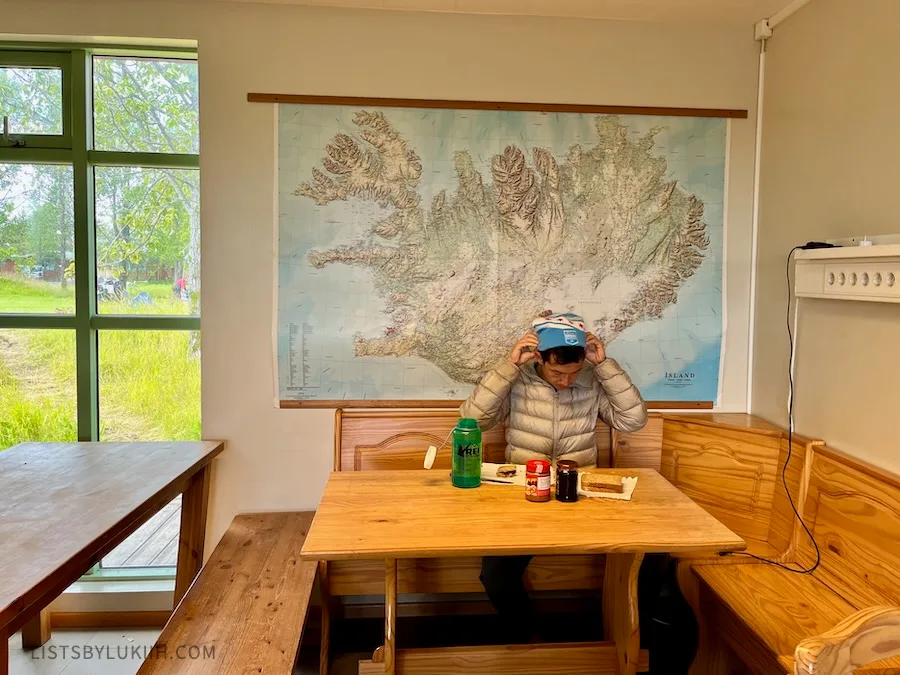
💰 4. Iceland campsites are not free.
Iceland campsites are generally well-maintained, so they have fees. The average campsite cost in Iceland is $15 per person per night. Some have extra shower fees (e.g., $2 to $3 per three to five minutes of hot water).
Depending on how many nights you spend in Iceland, you can potentially save money on campsites by buying the Iceland Camping Card. This card gives a family access to specific campsites for a fixed cost.
Campsites will also have signs explaining how to pay. Different payment methods are available, including paying at the reception when you arrive, paying the campsite manager when they come in the morning or at night, and leaving money in a box.
🍀 My Campervan Experience: I spent $100 campervanning in Iceland, which averaged $14 per day. I share my Iceland budget breakdown here.
✏️ 5. Google reviews will tell you valuable campsite information.
Google reviews will tell you valuable campsite information that is not readily advertised. For example:
- Hot showers – Reviews will tell you whether a campsite has hot showers. Some campsites claim they do when they don’t.
- Crowds – Reviews will tell you whether a campsite is crowded the week of your visit (make sure to sort by “recent reviews”).
If you want to shower without relying on campsites, visit a hot spring with a shower facility. I enjoyed my showers at Blue Lagoon and Secret Lagoon the most.

☀️ 6. Not all Iceland campsites are open year-round.
Double-check a campsite’s availability, especially if you’re traveling during the winter season.
🍀 My Campervan Experience: I went in the summer, the best time of year to campervan, so this wasn’t an issue for me. My friend who went during the colder months said many campsites were closed.
I list all the campsites I stayed at in my Iceland road trip itinerary.
3 Tips on Planning Meals During Your Campervan Trip in Iceland
When traveling around Iceland by campervan, you can eat out, cook at a kitchen facility, or use your van’s equipment to cook your meals.
Restaurants and grocery stores are not readily available everywhere in Iceland, so you need to plan your meals a day or two ahead.
🍝 1. Not all Iceland grocery stores are created equal.
Iceland has several popular grocery stores you will repeatedly see during your road trip.
- Bonus – budget grocery store.
- Kronan – a larger grocery store with a broader selection of options.
- Netto – a smaller grocery store with a more limited selection.
You’ll also see 10-11 grocery stores that are open 24/7. However, you should only shop at a 10-11 if you’re desperate, as these are more tourist-focused and overpriced.
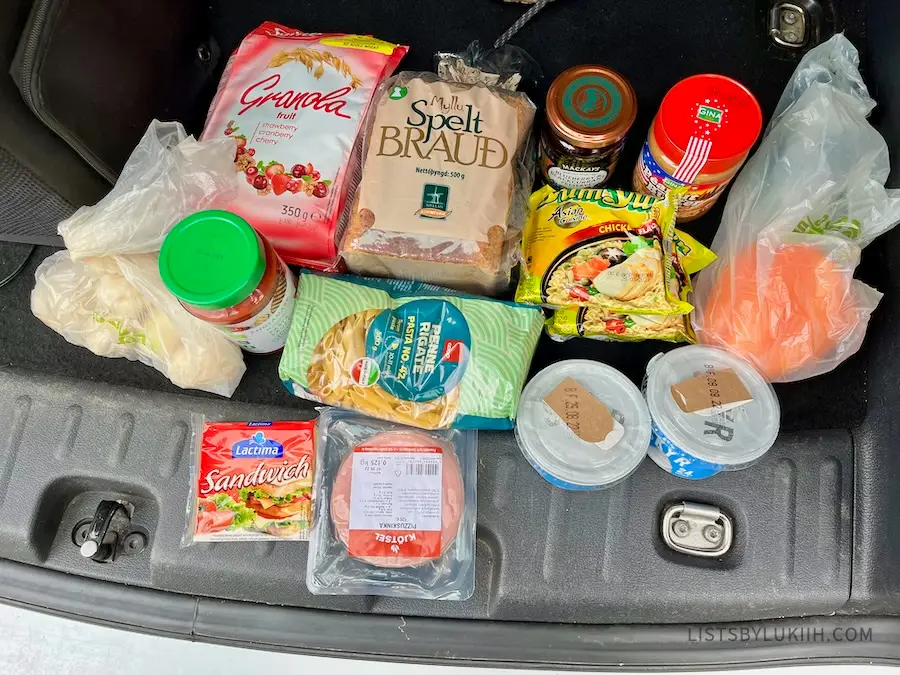
🌭 2. Consider getting a meal at an Iceland gas station.
Unlike the gas stations in the United States, the ones in Iceland are great places to have a cheap meal.
Gas station hot dogs in Iceland are particularly delicious and affordable. For example, the popular Skaftafell area has limited dinner options, so many people eat at the nearby Orkan gas station.
Iceland’s food is expensive because farming is difficult in its climate, and the country needs to import a lot of farm equipment and food.
🧼 3. Check your campervan’s supply list if you plan to cook.
Many campervans will provide the essential equipment for cooking a meal (e.g., stove, gas, knives, plates, utensils).
However, you will likely need to buy certain things to improve your camper cooking experience. For example, my van was missing salt and pepper, napkins, sponges, and dish soap.
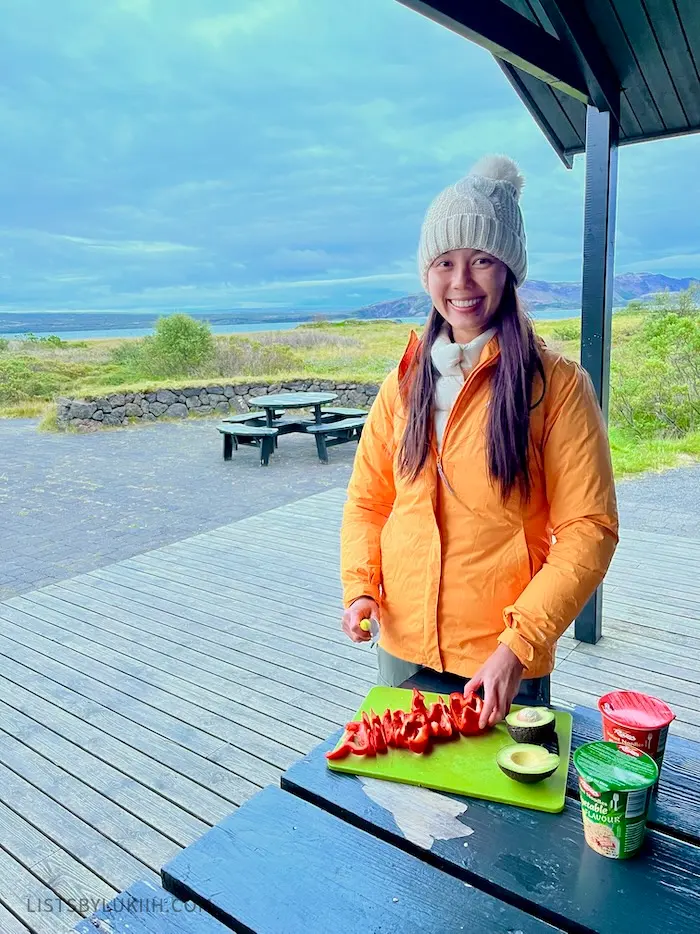
5 Things To Know About Driving in Iceland
Driving in Iceland is beautiful, but the country also has unique rules and driving norms.
After spending more than 20 hours driving on Iceland’s roads, these are the five things you should know about driving in Iceland.
🛑 1. Iceland has several unique road rules.
Driving in Iceland is different from driving in other European countries. Here’s an overview of Iceland road rules you may not be familiar with:
- One-lane bridges – In Iceland, the car closest to the bridge has the right of way. Some bridges will have light signals; most will not. These are relatively common.
- Headlights – Headlights must be on at all times in Iceland, including during the daytime. This is legally required.
- Roundabouts – The main thing to know about Iceland’s roundabouts is that the inner lane has the right of way to exit (which is strange if you’re not used to it). If you’re in the outer lane, you must stop for a car exiting from the inner lane. During my trip, multi-lane roundabouts were only common near Reykjavík.
- Speed limits – The speed limit in Iceland is relatively low (90 kph/56 mph on highways). Iceland has speed cameras with expensive fines costing over $300. I didn’t run into many of them outside of Reykjavík.
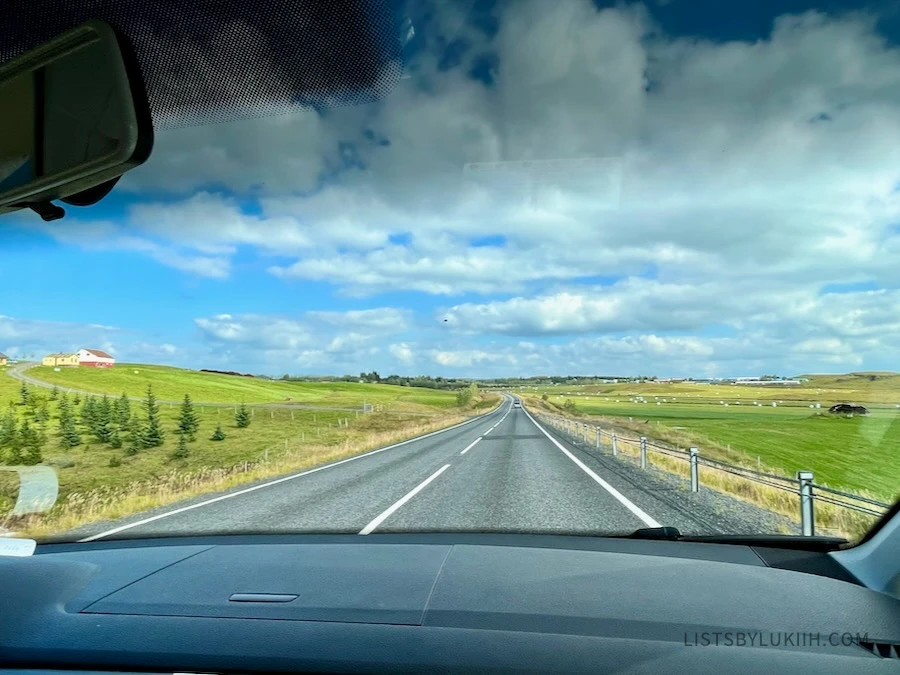
🚗 2. Passing is common on the Ring Road.
The Ring Road has a single lane in each direction most of the time. It’s common for there to be a slow car enjoying the views, so passing is very common, especially during the peak season.
Expect to pass and be passed. Always be careful when passing!
🐑 3. Watch out for animals while driving.
Over 75% of Iceland is uninhabited, so you’ll see endless nature and animals while driving. Sheep and other animals are common on the road while you travel around the country.
Fun fact: Iceland has about 800,000 sheep and only about 380,000 people.
💨 4. Hold the campervan door during strong winds.
Doors flying off is a common issue in Iceland, and they’re not covered by insurance. Holding your door is especially important during the winter months.
It’s worth repeating that Iceland’s weather is volatile. Check the daily up-to-date road conditions and wind conditions to stay safe and avoid driving during really bad weather.
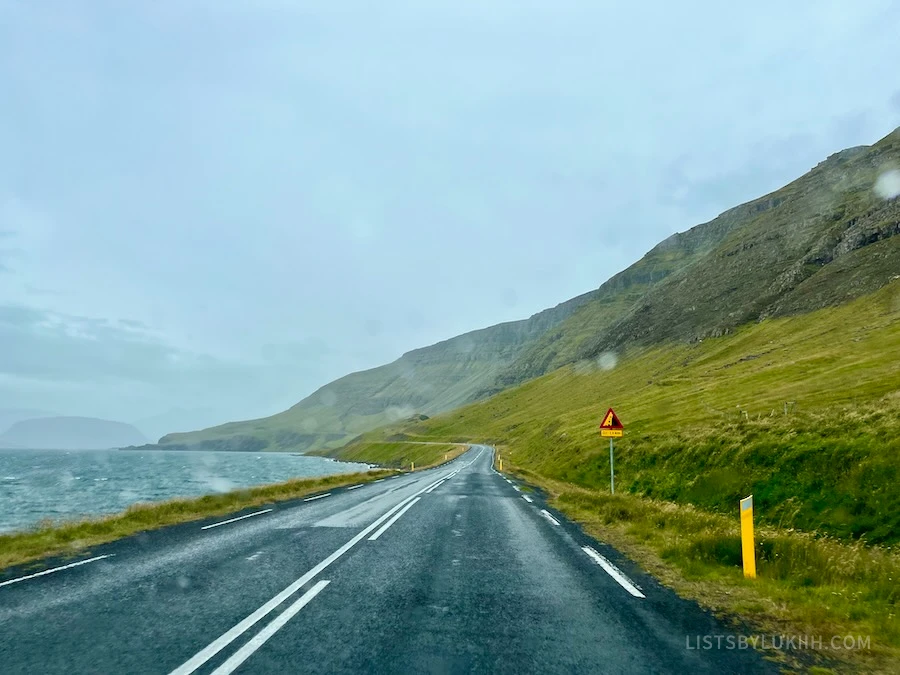
⛽️ 5. Gas is expensive, and you might have to pay inside.
Gas is expensive in Iceland; you can easily spend over $400 on gas driving around the Ring Road. As of January 2024, gas costs over $8 per gallon in Iceland.
Also, although Iceland has a fantastic credit card infrastructure, you’ll sometimes find that gas station pumps don’t accept your credit or debit card. Some pumps will show an error when you insert your card (this happened to me a few times). If your card doesn’t work, you can pay at the counter.
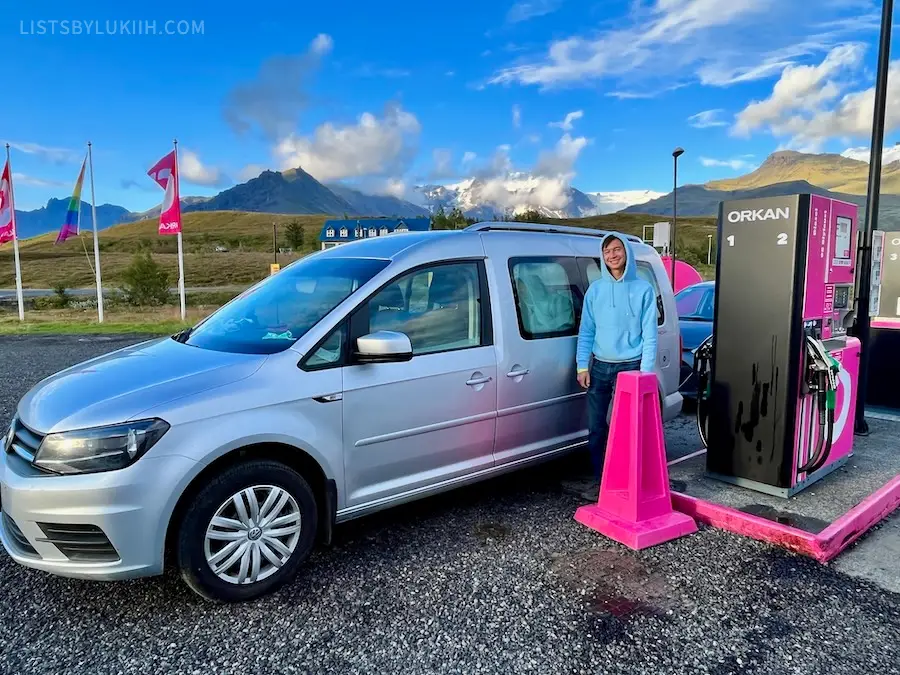
What To Pack for an Iceland Campervan Trip
When campervanning in Iceland, you’ll have to pack differently than when staying in a hotel, hostel, or tent. Below is a detailed packing list for an Iceland campervan trip.
🎒 What Bag To Bring for a Campervan Trip in Iceland
I usually travel with a carry-on, but I highly recommend packing in a duffel bag if you’re campervanning in Iceland. A duffel bag makes accessing belongings, handling, and storing in a limited space easier.
I was able to fit my entire Iceland camper packing list into a 25L backpack and a 55L duffel bag, with some room to spare.
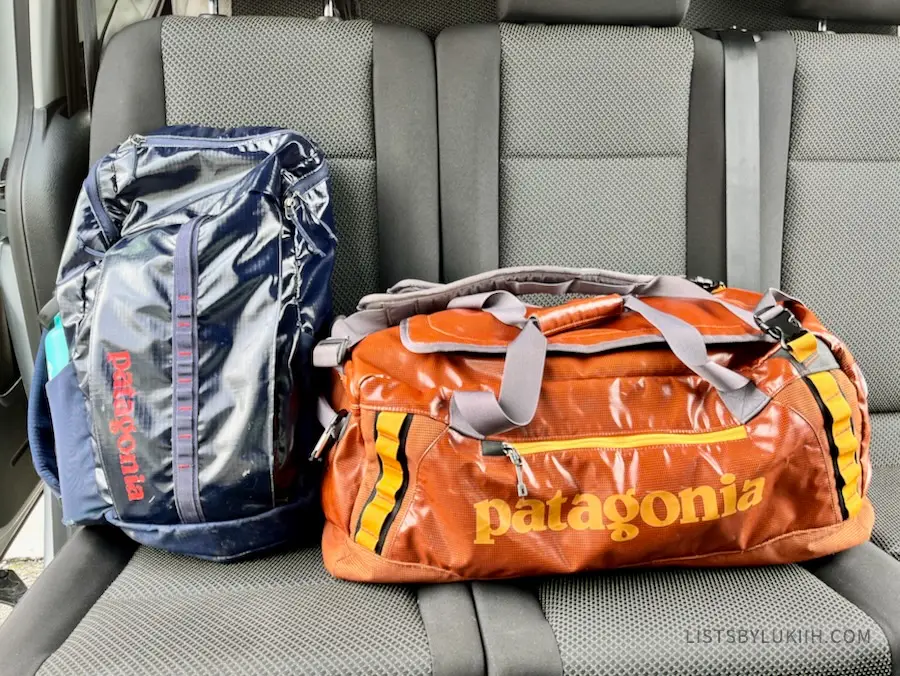
🥾 Shoes
- Waterproof hiking shoes – Iceland’s weather is unpredictable, even in the summer. Waterproofing is key. I wore my Salomon hiking boots every day and was comfortable throughout the week despite being worried about spending so much time in hiking boots.
If you plan to do a glacier hike in Iceland, you’ll need hard, ankle-protected boots, which my boots were not.
- Flip flops or sandals – You’ll want to pack sandals for showers and hot springs.
Some Iceland campsites don’t allow outdoor shoes inside the kitchen facility, so you’ll want something easy to slip on and off. I wore my Chacos, which worked, but I wished I had invested in Crocs for easier slip-on and off.
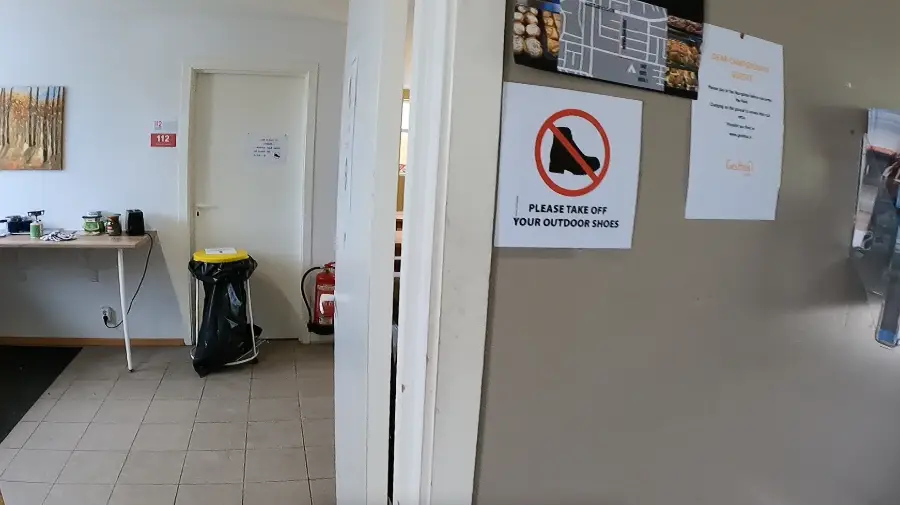
🧦 Clothes
- Swimsuit (1-2) – You’ll need at least one pair of swimsuits for the Iceland hot springs.
- Hiking pants (2+) – My biggest regret was not packing a pair of waterproof pants. I got soaked and cold while hiking in the rain and visiting powerful waterfalls. I bought these quick-dry hiking pants specifically for this trip, and they were amazing (very quick to dry) on the days I didn’t get too wet.
- Rain jacket and rain poncho – I wore this rain jacket daily and was happy with it. I also packed this rain poncho, which I wore over my rain jacket during my very wet hike to Glymur Waterfall.
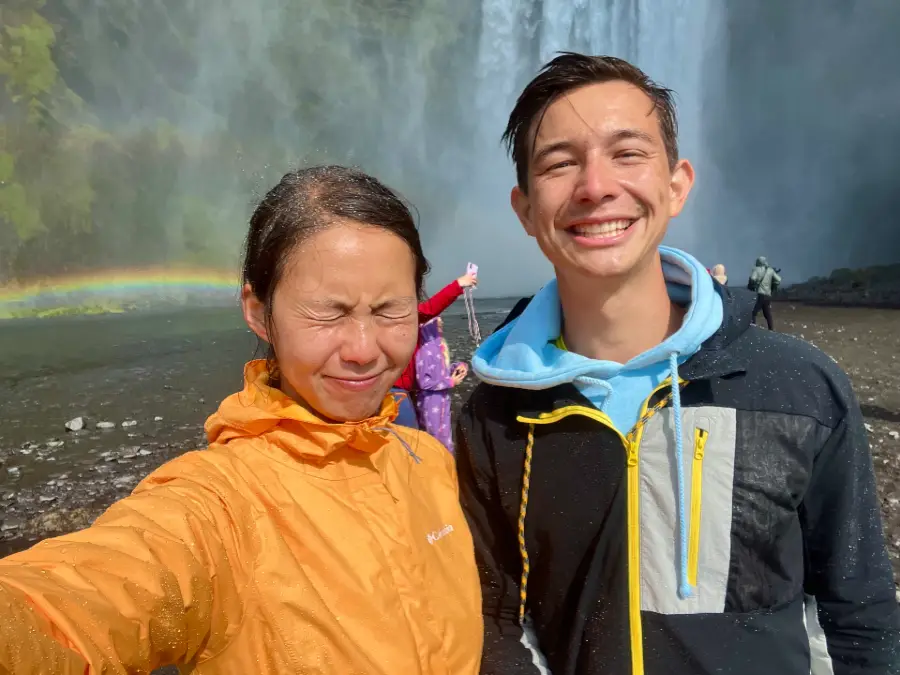
- Warm pajamas – You’ll want warm PJs if the camper’s heating system shuts off, or you need to step outside for a bathroom break at night. I bought these fleece leggings that worked well.
- Sun hoodie (2+) – Some recommend bringing short sleeves or tanks, but I thought sun hoodies worked better for the warmer moments due to the sun and wind.
- Warm hiking socks (7+) – Bring extra socks. It’s hard to dry clothes, and getting wet in Iceland is easy due to waterfalls, sudden rain, or accidentally missing a step in a river crossing. I packed three light, four heavy, and two regular socks.
- Packable down jacket (outer layer) – Bring a down jacket that’s easy to pack away since you can switch layers often.
- Warm thermal base (inner layer) – Being able to layer is vital. I packed my Smartwool tops and bottoms. Fleece-lined leggings will work as well.
- Sweater or hoodie (middle layer) – Bring a warm layer to wear between your outer and inner layers. Fleece or wool are great options.
- Airplane clothes – I missed this and wished I had brought a clean set of clothes for my flight home.
🧤 Accessories
- Headband and hat – I packed both and was glad I did when my headband got soaked and couldn’t be conveniently dried.
- Waterproof gloves – You’ll especially want a pair of gloves if you do a glacier hike.
- Sleeping mask – You’ll want sleeping masks if your camper doesn’t completely block out the sun. I bought this sleeping mask specifically for Iceland. They worked well for me, but you might need a heavier pair if you’re sensitive to light.
Iceland’s sun sets late and rises early, especially in the summer months.
- Sunglasses – The sun in Iceland is intense, making sunglasses helpful for driving and hiking. I carried my Goodr sunglasses everywhere.
- Earplugs – In crowded campsites, your neighbor’s campervan might park closer than you like, and its inhabitants might sleep later or wake up earlier than you.
☀️ Personal Care
- Toiletry bag with a hook – One of my biggest mistakes was bringing a toiletry bag without a hook, which made it difficult/impossible to put my bag down in the campsite bathrooms. All the campsites I stayed at offered hooks for hanging toiletry bags.
- Toiletries – Campsites don’t offer toiletries, so make sure to bring some.
- Scrunchies (for long hair) – You may not want to dip your hair in the hot springs.
Minerals in hot springs can cause hair dryness. The Blue Lagoon’s high silica content makes hair stiff and difficult to manage.
- Sunscreen – While you’ll mostly be in layers, you’ll need face sunscreen at a minimum. I highly recommend this lightweight travel-size face sunscreen.
Iceland is further up in the Arctic Circle and closer to the sun. People have gotten sunburnt in Iceland.
🔋 Electronics
- Waterproof phone case – You’ll want a case for the rain and hot springs (especially the famous Blue Lagoon). I carried a waterproof phone case to all the hot springs I visited.
- Plug adapter – Iceland uses the standard Europlug (two prongs with round pins). I bought this universal adapter for this trip and was able to charge my electronics at some stops.
- Phone charger (USB) – Most campervans offer USB charging, so you’ll want to bring a charger while driving. Check your campervan’s description to make sure it has USB charging.
- Portable battery pack – Because charging can sometimes be slow in a campervan, I found it helpful to have a battery pack when I needed an extra boost and couldn’t charge fast enough.
🚰 Miscellaneous Items
- Quick dry towel (1-2) – You’ll need towels for showers and the hot springs. I packed my quick dry towel and wished I had brought two separate ones for hot springs and showers for cleanliness.
Some hot springs will offer towels (e.g., Blue Lagoon as part of your entry fee, Secret Lagoon for an additional fee), but not all will (e.g., Hrunalaug Hot Spring).
- Small towels – You’ll need a towel to wipe up messes and windshield condensation in the mornings. I didn’t bring any and had to use dirty clothes.
- Day pack – You’ll likely do at least one hike and need something to carry your water and the many layers you’ll need. Make sure you have a way to waterproof your bag.
- Reusable water bottle – There’s no need to buy bottled water in Iceland. I packed my Hydro Flask everywhere.
Iceland’s water is among the cleanest in the world, and over 90% comes from natural springs.
- Wet wipes – You may have days where you don’t have access to a shower facility, and wet wipes can be somewhat of a substitute. Remember that some Iceland campsites claim they have shower facilities when they don’t.
- Reusable plastic bag – You’ll want one for grocery shopping as Iceland has banned stores from providing plastic bags to shoppers for environmental reasons.
- Ziploc bags – Iceland doesn’t seem to carry Ziploc bags, and you might want one to pack a sandwich for a day hike or to carry waterproof items. You can also bring a reusable sandwich bag.
- Trash bag – You’ll need to create a temporary trash bag inside your camper sometimes.
- Headlamp (optional) – You’ll need headlamps to navigate inside your campervan on dark, cloudy nights. However, I found my phone’s flashlight sufficient.
Iceland’s sun sets late. It remained bright outside late into the night (even at 3 am). I only needed the headlamp during cloudy nights or when visiting dark bathroom stalls.

Iceland Campervan Trip Planner
Iceland Trip Planner 2025
Make planning easier with my flexible, research-backed travel planner—shaped by real experience. It has:
- Up-to-date travel info
- A well-curated itinerary
- Practical, firsthand insights & tips
- A simple budget tracker
- A starter packing list
- Fully customizable sections
Built in Notion, this is the tool I personally use to plan every trip. I genuinely love it and creating a Notion account is free.
Lists by Lukiih is a small site I fund myself. Downloading my trip planner is the best way to support me and keep it running—thanks!
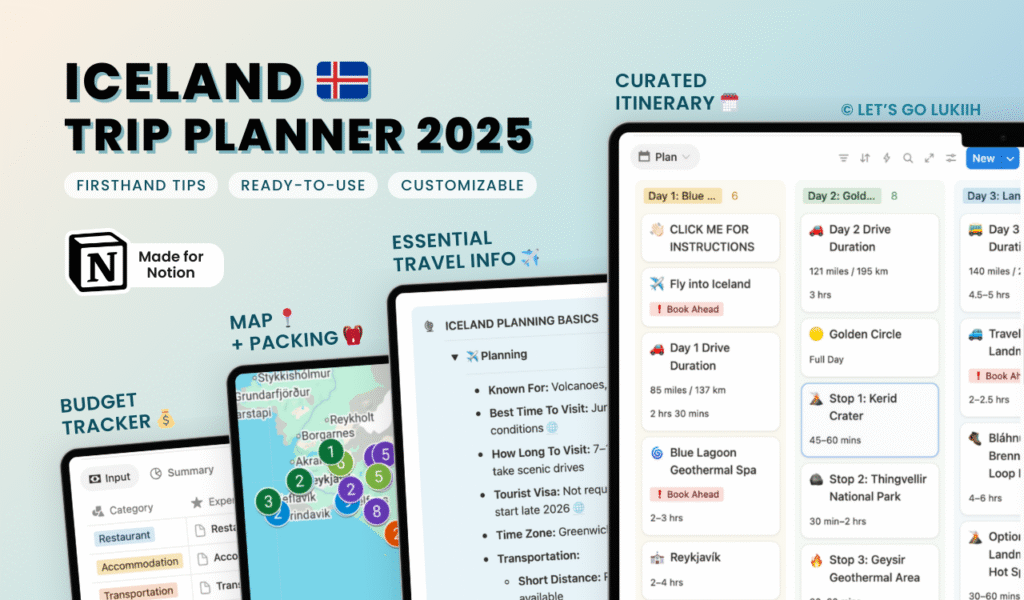
Iceland Travel Guides
- 🇮🇸 Planning a Trip to Iceland: 11 Practical Things To Know
- 🚙 Iceland South Coast: Efficient 7-Day Road Trip Itinerary
- 🚐 My Iceland Campervan Trip: How To Plan One + Tips
- 💰 My Iceland Trip Cost: My Budget Breakdown (2025)
- 🧊 Hiking a Glacier in Iceland: My Honest Review & Tips
- ♨️ Hrunalaug Hot Spring: My Honest Review & Tips
- ☀️ Visiting Iceland in August: Tips & What To Know
